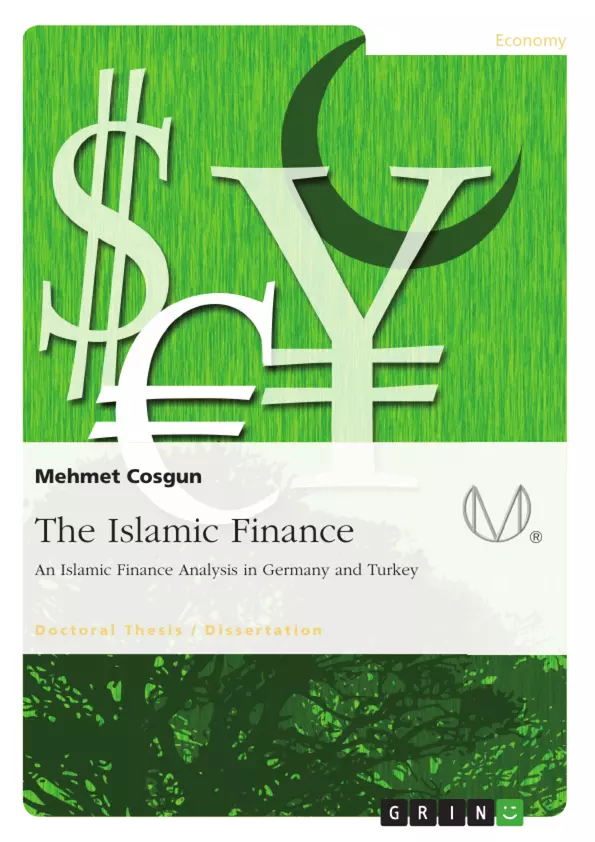This work analyzes whether in recent years Islamic financial developments apply globally, for example to Germany. The author is interested in the reality of Islamic finance and its potential existence in non-Muslim environments. In much of the extant literature, studies consider a theoretical model such as: “The stability of Islamic finance”.
The authors in these studies tend to focus on global Islamic banks. In the present study, the Author wants to examine the situation for a specific non-Muslim country like Germany. The second focus is to find out whether there is a relationship between the number of Muslims in Germany and the need for Islamic financial products. A detailed view of market entry and critical key indicators are analysed. The current laws and their handling by Islamic banks will additionally be examined. To complete this research, a comparison with a country with more real market experiences in the field of Islamic finance, such as Turkey, will be undertaken.
Are there certain Islamic, Jewish, Christian Practices and Aims for Business?
With this background, starting from the year 2000, the author observed and investigated economics sources. Here, the concrete issue of Islamic finance became more and more compelling. The development of Islamic finance in recent decades is characterized by increasing, worldwide market share. With the most recent crisis of 2008, Islamic finance strengthened its global attention. This was due to profit increases throughout the period of crisis.
Inhaltsverzeichnis (Table of Contents)
- Abstract
- Abtrakt
- Chapter 1: Introduction
- Chapter 2: Islamic Economics, Islamic Finance and Islamic Banking
- 2.1: The Islamic Economics
- 2.2: Islamic Finance
- 2.3: Islamic Banking
- Chapter 3: The Theoretical Fundamentals of Islamic Banking
- 3.1: Theoretical Foundations
- 3.2: Islamic Financial Products
- 3.3: Islamic Financial Institutions
- Chapter 4: The Islamic Finance in Germany
- 4.1: Development of Islamic Finance in Germany
- 4.2: Market Entry of Islamic Banks to Germany
- 4.3: Critical Key Indicators of Islamic Finance in Germany
- Chapter 5: Islamic Finance in Turkey
- 5.1: Development of Islamic Finance in Turkey
- 5.2: Market Entry of Islamic Banks to Turkey
- 5.3: Critical Key Indicators of Islamic Finance in Turkey
- Chapter 6: Conclusion
- Bibliography
Zielsetzung und Themenschwerpunkte (Objectives and Key Themes)
This dissertation aims to analyze the current state of Islamic finance in Germany and Turkey, focusing on the potential for Islamic banking in non-Muslim environments. The work explores the practical application of Islamic financial principles in these countries, particularly examining the relationship between the Muslim population and the demand for Islamic financial products.- The feasibility and growth potential of Islamic banking in non-Muslim countries
- The influence of the Muslim population on the demand for Islamic financial services
- The challenges and opportunities of market entry for Islamic banks in Germany and Turkey
- Comparison of the Islamic finance landscape in Germany and Turkey, highlighting key differences and similarities
- Analysis of the legal and regulatory framework surrounding Islamic finance in both countries
Zusammenfassung der Kapitel (Chapter Summaries)
- Chapter 1: Introduction provides a comprehensive overview of Islamic finance, highlighting its core principles and key concepts. It establishes the context for the research, outlining the objectives and scope of the dissertation.
- Chapter 2: Islamic Economics, Islamic Finance and Islamic Banking delves into the theoretical foundations of Islamic finance, examining the principles of Islamic economics and its implications for financial practices. It explores the specific features of Islamic banking and its distinct characteristics.
- Chapter 3: The Theoretical Fundamentals of Islamic Banking further explores the theoretical underpinnings of Islamic banking, analyzing the principles of risk sharing, interest-free banking, and other key aspects of Islamic financial institutions.
- Chapter 4: The Islamic Finance in Germany focuses on the development of Islamic finance in Germany, examining the factors influencing its growth, the challenges faced by Islamic banks in the German market, and the legal framework governing their operations.
- Chapter 5: Islamic Finance in Turkey provides a comparative analysis of Islamic finance in Turkey, highlighting the key differences and similarities between the Turkish and German markets. The chapter explores the growth of Islamic finance in Turkey and the factors driving its success.
Schlüsselwörter (Keywords)
This dissertation explores the key concepts of Islamic economics, Islamic finance, and Islamic banking, specifically analyzing their application in the German and Turkish markets. The research examines the challenges and opportunities of market entry for Islamic banks in these countries, highlighting the significance of the Muslim population and its influence on the demand for Islamic financial products. The study also explores the legal and regulatory framework surrounding Islamic finance in both countries, providing valuable insights into the current landscape of Islamic finance in non-Muslim environments.- Citation du texte
- Mehmet Cosgun (Auteur), 2014, The Islamic Finance, Munich, GRIN Verlag, https://www.grin.com/document/282437



